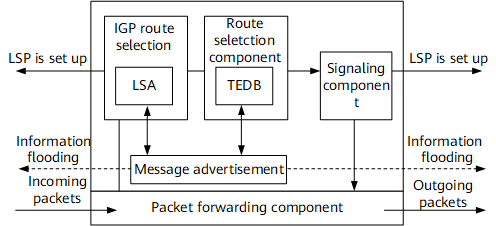OSPF TE
OSPF Traffic Engineering (TE) is developed based on OSPF to support Multiprotocol Label Switching (MPLS) TE and establish and maintain TE LSPs. In the MPLS TE architecture described in "MPLS Feature Description", OSPF functions as the information advertising component, responsible for collecting and advertising MPLS TE information.
In addition to the network topology, TE needs to know network constraints, such as the bandwidth, TE metric, administrative group, and affinity attribute. However, current OSPF functions cannot meet these requirements. Therefore, OSPF introduces a new type of LSA to advertise network constraints. Based on the network constraints, the Constrained Shortest Path First (CSPF) algorithm can calculate the path that meets various constraints.

OSPF in the MPLS TE Architecture
In the MPLS TE architecture, OSPF functions as the information advertising component:
Collects related information about TE.
Floods TE information to devices in the same area.
Uses the collected TE information to form the TE database (TEDB) so that CSPF can calculate routes.
OSPF does not care about information content or how MPLS uses the information.
TE-LSA
OSPF uses a new type of LSA (Type 10 opaque LSA) to collect and advertise TE information. Such LSAs contain the link status information required by TE, including the maximum link bandwidth, maximum reservable bandwidth, current reserved bandwidth, and link color. Based on the OSPF flooding mechanism, Type 10 opaque LSAs synchronize link status information among devices in an area to form a uniform TEDB for route calculation.
Interaction Between OSPF TE and CSPF
OSPF uses Type 10 LSAs to collect TE information in an area, such as the bandwidth, priority, and link metrics. After processing the collected TE information, OSPF provides it for CSPF to calculate routes.
IGP Shortcut and Forwarding Adjacency
OSPF supports IGP shortcut and forwarding adjacency. The two features allow OSPF to use a tunnel interface as an outbound interface to reach a destination.
Differences between IGP shortcut and forwarding adjacency are as follows:
An IGP shortcut-enabled device uses a tunnel interface as an outbound interface but does not advertise the tunnel interface to neighbors. Therefore, other devices cannot use this tunnel.
A forwarding adjacency-enabled device uses a tunnel interface as an outbound interface and advertises the tunnel interface to neighbors. Therefore, other devices can use this tunnel.
IGP shortcut is unidirectional and needs to be configured only on the device that uses IGP shortcut.
OSPF SRLG
OSPF supports the applications of the Shared Risk Link Group (SRLG) in MPLS by obtaining information about the TE SRLG flooded among devices in an area. For details, refer to the chapter "MPLS" in this manual.
OSPF TE Tunnel Anti-Microloop
If a network fault occurs, IGP convergence is triggered. In this case, a transient forwarding status inconsistency may occur among nodes because of their different convergence rates, which poses the risk of microloops. If the outbound interface of a route before IGP convergence is a shortcut TE tunnel interface and the OSPF TE tunnel anti-microloop function is enabled, the outbound interface of the route remains unchanged during the IGP convergence. In this case, traffic is forwarded through a hot standby TE tunnel, and the forwarding process does not depend on IGP convergence on each device, preventing microloops.